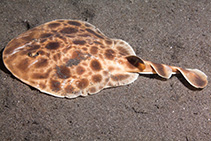http://www.fishbase.org/Summary/speciesSummary.php?genusname=Narcine&speciesname=lingula ---> http://192.134.151.83/Summary/speciesSummary.php?genusname=Narcine&speciesname=lingula
http://192.134.151.83/Summary/speciesSummary.php?genusname=Narcine&speciesname=lingula ---> https://fishbase.mnhn.fr/Summary/speciesSummary.php?genusname=Narcine&speciesname=lingula
https://fishbase.mnhn.fr/Summary/speciesSummary.php?genusname=Narcine&speciesname=lingula ---> https://fishbase.mnhn.fr/summary/Narcine-lingula.html
Narcine lingula, Chinese numbfish

You can
sponsor
this page
Common name (e.g. trout)
Genus + Species (e.g. Gadus morhua)
-

-
About this page
-
Languages
-
User feedbacks
-
Citation
-
Uploads
-
Related species
-


 Chinese numbfish
Add your observation in
Fish Watcher
Upload your
photos
and
videos
Chinese numbfish
Add your observation in
Fish Watcher
Upload your
photos
and
videos
Pictures
|
Google image
 Narcine lingula
Narcine lingula
Picture by
Malaer, P.
Elasmobranchii (sharks and rays) >
Torpediniformes
(Electric rays) >
Narcinidae
(Numbfishes)
Etymology:
Narcine:
Greek, narke = numbness (Ref.
45335
)
.
More on author:
Richardson
.
Environment: milieu / climate zone / depth range / distribution range
Ecology
Marine; demersal. Subtropical; 38°N - 10°N, 62°E - 138°E (Ref.
114953
)
Indo–West Pacific; Pakistan to East China Sea (Shanghai), including Taiwan and possibly Japan and Philippines. Conservation status maybe of concern in Northwest Pacific because of its inshore benthic habitat, low abudance, and the presence of intensive demersal fisheries (Ref.
47737
).
Size / Weight / Age
Maturity: L
m
?
range ? - ? cm
Max length : 35.0 cm TL male/unsexed; (Ref.
114953
); common length : 30.0 cm TL male/unsexed; (Ref.
114953
)
Preorbital length about equal to preoral length (and much greater than prenasal length), and dark brown spots that are usually greater than eye diameter over a brown background (Ref.
49866
).
Found in continental waters, both inshore and offshore (Ref.
9912
). Biology little known (Ref.
9912
). Maturity size of males at ca. 24 cm TL, birth size at ca. 11 cm TL (Ref.
114953
).
Life cycle and mating behavior
Maturity
|
Reproduction
|
Spawning
|
Eggs
|
Fecundity
|
Larvae
de Carvalho, M.R. and J.E. Randall
, 2003. Numbfishes from the Arabian Sea and surrounding gulfs, with the description of a new species from Oman (Chondrichthyes: Torpediniformes: Narcinidae). Ichthyol. Res. 50(1):59-66. (Ref.
49866
)
IUCN Red List Status (Ref.
130435
)
Vulnerable (VU)
(A2d); Date assessed:
06 May 2020
CITES
Not Evaluated
Not Evaluated
Threat to humans
Other (Ref.
10011
)
Human uses
FAO - Publication:
search
|
FishSource
|
More information
Countries
FAO areas
Ecosystems
Occurrences
Introductions
Stocks
Ecology
Diet
Food items
Food consumption
Ration
Common names
Synonyms
Metabolism
Predators
Ecotoxicology
Reproduction
Maturity
Spawning
Spawning aggregation
Fecundity
Eggs
Egg development
Age/Size
Growth
Length-weight
Length-length
Length-frequencies
Morphometrics
Morphology
Larvae
Larval dynamics
Recruitment
Abundance
BRUVS
References
Aquaculture
Aquaculture profile
Strains
Genetics
Electrophoreses
Heritability
Diseases
Processing
Nutrients
Mass conversion
Collaborators
Pictures
Stamps, Coins Misc.
Sounds
Ciguatera
Speed
Swim. type
Gill area
Otoliths
Brains
Vision
Tools
E-book
|
Field guide
|
Identification keys
|
Length-frequency wizard
|
Life-history tool
|
Point map
|
Classification Tree
|
Catch-MSY
|
Special reports
Check for Aquarium maintenance
|
Check for Species Fact Sheets
|
Check for Aquaculture Fact Sheets
Download XML
Summary page
|
Point data
|
Common names
|
Photos
Internet sources
AFORO (otoliths) |
Aquatic Commons
|
BHL
|
Cloffa
|
BOLDSystems
|
Websites from users
|
Check FishWatcher
|
CISTI
|
Catalog of Fishes
:
genus
,
species
|
DiscoverLife
|
ECOTOX
| FAO - Publication:
search
|
Faunafri
| Fishipedia |
Fishtrace
| GenBank:
genome
,
nucleotide
| GloBI |
Google Books
|
Google Scholar
|
Google
| IGFA World Record |
MitoFish
|
National databases
|
Otolith Atlas of Taiwan Fishes
|
PubMed
| Reef Life Survey | Socotra Atlas |
Tree of Life
| Wikipedia:
Go
,
Search
| World Records Freshwater Fishing |
Zoobank
|
Zoological Record
Estimates based on models
Preferred temperature (Ref.
123201
): 22.8 - 28.6, mean 27.1 °C (based on 1300 cells).
Phylogenetic diversity index (Ref.
82804
): PD
50
= 0.5000 [Uniqueness, from 0.5 = low to 2.0 = high].
Bayesian length-weight: a=0.01175 (0.00476 - 0.02897), b=2.88 (2.66 - 3.10), in cm total length, based on LWR estimates for this (Sub)family-body shape (Ref.
93245
).
Trophic level (Ref.
69278
): 3.1 ±0.3 se; based on size and trophs of closest relatives
Resilience (Ref.
120179
): Low, minimum population doubling time 4.5 - 14 years (Assuming fecundity<100).
Fishing Vulnerability (Ref.
59153
): Low vulnerability (25 of 100).
Back to Search
Random Species
Back to Top
Accessed through:
Not available
FishBase mirror site :
localhost
Page last modified by :
mrius-barile
- 20 July 2016
Fatal error
: Uncaught ArgumentCountError: Too few arguments to function checkEcotox(), 1 passed in /var/www/html/summary/speciessummary.php on line 2304 and exactly 3 expected in /var/www/html/includes/speciessummary.lib.php:2579 Stack trace: #0 /var/www/html/summary/speciessummary.php(2304): checkEcotox() #1 {main} thrown in
/var/www/html/includes/speciessummary.lib.php
on line
2579
|